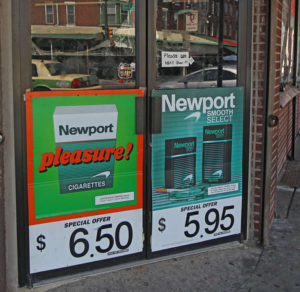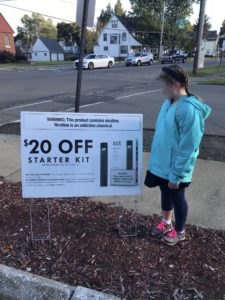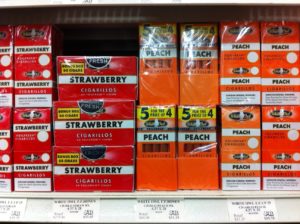Welcome to CounterTobacco.org’s “News and Research Roundup!” Each month we post a summary of the latest research, reports, and news stories on counteracting tobacco product sales and marketing at the point of sale (POS). Keeping up with what’s happening in the POS movement all across the country can help you choose policies and strategies that work best for your community. New research can help provide support for your work and evidence for the importance of the “War in the Store.” Have a story you don’t want us to miss? E-mail it to us!
New Research
Menthol and Other Flavored Tobacco Products
- Modelling the impact of menthol sales restrictions and retailer density reduction policies: Insights from tobacco town Minnesota, Tobacco Control
- Using modeling simulations, researchers examined the impact of various point-of-sale
 policies on the direct costs (i.e. purchasing price) and indirect costs (i.e. travel costs, opportunity costs) of purchasing cigarettes, which, in turn, affect purchasing behaviors and tobacco use. They found that, of all the policies they tested, restricting sales of all cigarettes or just menthol cigarettes to tobacco specialty stores could have the largest impact on cigarette purchasing costs, though coupling this policy with others, like establishing a minimum distance between tobacco retailers, could further maximize the effectiveness and impact. The researchers also highlighted the importance of context when implementing point-of-sale policies; for instance, low income, urban communities, which tend to have higher rates of retailer density, may need multiple, stronger policies to equitably impact cigarette purchasing costs. Learn more about point-of-sale policy solutions and health equity in point-of-sale tobacco control.
policies on the direct costs (i.e. purchasing price) and indirect costs (i.e. travel costs, opportunity costs) of purchasing cigarettes, which, in turn, affect purchasing behaviors and tobacco use. They found that, of all the policies they tested, restricting sales of all cigarettes or just menthol cigarettes to tobacco specialty stores could have the largest impact on cigarette purchasing costs, though coupling this policy with others, like establishing a minimum distance between tobacco retailers, could further maximize the effectiveness and impact. The researchers also highlighted the importance of context when implementing point-of-sale policies; for instance, low income, urban communities, which tend to have higher rates of retailer density, may need multiple, stronger policies to equitably impact cigarette purchasing costs. Learn more about point-of-sale policy solutions and health equity in point-of-sale tobacco control.
- Using modeling simulations, researchers examined the impact of various point-of-sale
- Changes in flavor preference in a cohort of long-term electronic cigarette users, Annals of the American Thoracic Society
- In this longitudinal study, 383 US adults who reported e-cigarette use were surveyed at baseline (2012-2014) and follow-up (2017-2019) to assess changes in e-cigarette flavor preference. 40% of the participants reported a preference for tobacco, menthol, or mint flavored e-cigarettes at baseline, though, at follow-up, only 22% reported a preference for these flavors. Preference for fruit-flavored e-cigarettes hovered around 23% at both baseline and follow-up. However, preference for chocolate, candy, and other ‘sweets’ flavors increased drastically from 16% at baseline to 29% at follow-up. This change in preference to sweet flavors was much more pronounced in younger participants (ages 18-45) as well as participants who only used e-cigarettes, compared to participants who used e-cigarettes and other tobacco products. As well, the researchers found that nearly half of participants stated they would ‘find a way’ to purchase their preferred flavor or would mix flavoring agents to create their preferred flavor if flavored e-cigarette products were banned by the FDA. Learn more about flavored tobacco products at the point of sale
- News story: US study assess flavour use patterns in long-term e-cigarette users, VapingPost.com
POS Advertising, Marketing & Promotions
- Association between school-based tobacco retailer exposures and young adolescent cigarette, cigar and e-cigarette use, Tobacco Control
- This study examined the association between middle school youth current tobacco product use and school-based retailer exposure in Cleveland, Ohio. No association was
 found between tobacco retailer density around schools or tobacco retailer proximity to schools and current use in middle school students across the Cleveland Metropolitan School District. However, frequency of walking to and from school and stopping at retailers before and after school were both strongly associated with current youth use. The researchers infer that this association is likely due to increased exposure to point-of-sale marketing and advertising. Learn more about retailer density, proximity, and licensing and restrictions on tobacco advertising and promotion.
found between tobacco retailer density around schools or tobacco retailer proximity to schools and current use in middle school students across the Cleveland Metropolitan School District. However, frequency of walking to and from school and stopping at retailers before and after school were both strongly associated with current youth use. The researchers infer that this association is likely due to increased exposure to point-of-sale marketing and advertising. Learn more about retailer density, proximity, and licensing and restrictions on tobacco advertising and promotion.
- This study examined the association between middle school youth current tobacco product use and school-based retailer exposure in Cleveland, Ohio. No association was
Disparities
- Boosting the Tobacco Control Vaccine: Recognizing the role of the retail environment in addressing tobacco use and disparities, Tobacco Control
- This article recognizes the retail environment as one of the primary places the tobacco industry promotes and markets its products, and highlights how population-level
 strategies to target these industry tactics in the retail environment could reduce smoking and tobacco-related health inequities across racial, ethnic, and socioeconomic lines. With a deep dive into five point-of-sale tobacco control strategies (availability; pricing and promotion; advertising and display; age of sale; and retail licensure), this commentary evidences the importance of focusing on the tobacco retail environment when designing and implementing a comprehensive approach to tobacco prevention and control. Learn more about point-of-sale policy options.
strategies to target these industry tactics in the retail environment could reduce smoking and tobacco-related health inequities across racial, ethnic, and socioeconomic lines. With a deep dive into five point-of-sale tobacco control strategies (availability; pricing and promotion; advertising and display; age of sale; and retail licensure), this commentary evidences the importance of focusing on the tobacco retail environment when designing and implementing a comprehensive approach to tobacco prevention and control. Learn more about point-of-sale policy options.
- This article recognizes the retail environment as one of the primary places the tobacco industry promotes and markets its products, and highlights how population-level
- Disparities in the prevalence of cigarette smoking among bisexual people: A systematic review, meta-analysis and meta-regression, Tobacco Control
- With data pulled from a total of 47 studies between 1995 and 2019, researchers found that individuals that identified as bisexual were 1.25 times as likely to report lifetime smoking, 1.17 times as likely to report past 30 day smoking, and 1.19 times as likely to report current smoking, compared to individuals that identified as lesbian or gay. Individuals that identified as bisexual were also 2.18 times as like to report lifetime smoking, 2.48 times as likely to report past 30 day smoking, and 2.26 times as likely to report current smoking compared to individuals that identified as heterosexual. Women who identified as bisexual had the greatest magnitude of cigarette smoking prevalence compared to all other sexual orientation/gender subpopulations. Learn more about disparities at the point of sale that impact inequities in tobacco use.
- How much progress have we made? Trends in disparities in tobacco use, Preventing Chronic Disease
- This article spotlights the persistence of disparities in tobacco use in Minnesota across education, income, and race despite significant efforts in tobacco control like comprehensive smoke-free laws and increased tobacco taxes. The findings highlight the need for more equity-informed and equity-focused policies and strategies to reduce disparities in tobacco use and tobacco-related harms. Learn more about health equity in point-of-sale tobacco control.
E-Cigarettes/Vape Shops
- Changes in knowledge, perceptions and use of JUUL among a cohort of young adults, Tobacco Control
- In this study, over 1,800 young adults were surveyed in the spring and fall of 2018. Over the course of these six months, both ever and current use of JUUL doubled, from 5.9% to 12.7% of participants reporting ever use and 1.6% to 3.4% reporting current
 use. As well, during just this six month window, reported exposure to JUUL advertising significantly increased from 31.8% to 46.4% of participants. Participants who reported exposure to JUUL advertising had significantly increased odds of current JUUL use at follow-up during the fall. On the other hand, participants who perceived JUUL as being “as or more harmful” than cigarettes and participants who self-reported as former or never cigarette smokers had significantly lower odds of JUUL use at follow-up. Also of note, though at follow-up there was an increase in the number of participants who recognized that JUUL pods have “as much or more nicotine than a pack of cigarettes”, over half of the sample was still “not sure” of the nicotine content in JUUL pods. Learn more about e-cigarettes at the point of sale and restrictions on product advertising.
use. As well, during just this six month window, reported exposure to JUUL advertising significantly increased from 31.8% to 46.4% of participants. Participants who reported exposure to JUUL advertising had significantly increased odds of current JUUL use at follow-up during the fall. On the other hand, participants who perceived JUUL as being “as or more harmful” than cigarettes and participants who self-reported as former or never cigarette smokers had significantly lower odds of JUUL use at follow-up. Also of note, though at follow-up there was an increase in the number of participants who recognized that JUUL pods have “as much or more nicotine than a pack of cigarettes”, over half of the sample was still “not sure” of the nicotine content in JUUL pods. Learn more about e-cigarettes at the point of sale and restrictions on product advertising.
- In this study, over 1,800 young adults were surveyed in the spring and fall of 2018. Over the course of these six months, both ever and current use of JUUL doubled, from 5.9% to 12.7% of participants reporting ever use and 1.6% to 3.4% reporting current
- “It’s really addictive and I’m trapped:” A qualitative analysis of the reasons for quitting vaping among treatment-seeking young people, Addictive Behaviors
- Researchers examined reasons for quitting vaping in 1,000 youth (ages 13-17) and 1,000 young adults (18-24). Half of participants reported quitting for health reasons (e.g. “I want my lungs back”). Other commonly reported reasons for quitting included financial costs (e.g. “I don’t have enough money to feed my addiction”), freedom from addiction (e.g. “It’s [vaping] taking over my life), and influence on social spheres (e.g. “It’s affecting my friendships”). These findings show the detrimental effects vaping has on youth and young adults and their motivations for quitting. Learn more about e-cigarettes at the point of sale and non-tax-based strategies to increase e-cigarette prices.
Health Warnings and Labeling
- Reactions to electronic nicotine delivery system (ENDS) prevention messages: Results from qualitative research used to inform FDA’s first youth ENDS prevention campaign, Tobacco Control
- Through 24 focus groups with a total of 159 teens (ages 12-17), researchers tested the effectiveness of different e-cigarette prevention messages. They found that messages with a focus on addiction were believable but not concerning enough for teens. The strongest, most persuasive messages expressed the negative health consequences of vaping. Learn more about point-of-sale health warnings.
Tobacco 21
- Development of a tobacco 21 policy assessment tool and state-level analysis in the USA, 2015-2019, Tobacco Control
- This article provides a tool for analyzing state-level Tobacco 21 (T21) policies. Furthermore, the authors use the instrument to examine the T21 policies in 16 states, which had adopted T21 by July 2019. The tool can be used to assess and inform future state-level T21 initiatives. Learn more about Tobacco 21.
Other
- Tobacco industry and public health responses to state and local efforts to end tobacco sales from 1969-2020, PLoS One
- This article examined public health responses and tobacco industry challenges to 22 proposals to end the sale of cigarettes or other tobacco products between 1969 and 2020 and across 5 states, 12 cities, and 1 county. While the first ordinance of this kind to pass was fairly recent (June 2019; Beverly Hills, CA), tobacco control advocates may be able learn from these findings across the past few decades and use this analysis to inform future advocacy efforts. Learn more about restrictions on product availability.
- US regulator adds to confusion around heated tobacco products, BMJ
- In this editorial, the authors discuss the difference between heated tobacco products (HTPs) and e-cigarettes and detail how the Food and Drug Administration’s recent authorization of the marketing of IQOS, Philip Morris International’s HTP, as a ‘modified risk tobacco product’ has escalated confusion around HTPs and their claims of safety. Learn more about the FDA authorization of IQOS marketing as ‘modified risk’.
COVID-19
- Exploitation of the COVID-19 pandemic by e-cigarette marketers, Tobacco Control
- Researchers examined COVID-19-related marketing across e-cigarette brand and vape

Images pulled from article store websites and social media accounts. At time of publication, they had collected over 300 COVID-19-themed e-cigarette promotional images, representing 21 e-cigarette brands and 41 online vaping stores. These images included promotions such as a receiving a free essential supply with a vaping purchase (e.g. hand sanitizer, toilet paper, or face mask with purchase of a vaping product) and pandemic-themed discounts (e.g. promo codes such as “stayhome” and discounts for “frontline medical staff”). Many vape shops and e-cigarette brands also framed vaping as an activity that could be done safely at home and touted the risks between vaping and COVID-19 as “misinformation” and “myth”. Moreover, one brand even advertised that their products would help alleviate pandemic-related stress and anxiety. Learn more about restrictions on product advertising and promotions.
- News story: Vaping ad tactics ‘exploited’ the pandemic, study says, CNN Health
- Researchers examined COVID-19-related marketing across e-cigarette brand and vape
Reports
- E-cigarette use among middle and high school students – United States, 2020, Centers for Disease Control and Prevention [CDC] Morbidity and Mortality Weekly Report
- This report highlights results and findings from the nationally-representative, school-based National Youth Tobacco Survey (NYTS). Data was collected between January and March of 2020 and includes self-reported responses from US middle school and high school students.
- News story: Vaping rates among teens declining, but addiction appears to be on the rise, according to CDC, Philly Voice
- E-cigarette unit sales, by product and flavor type – United States, 2014 – 2020, Centers for Disease Control and Prevention Morbidity and Mortality Weekly Report
- This report tracks sales of e-cigarettes in the US marketplace from September 2014 to
 May 2020. The document further details sales and trends by product type (prefilled cartridge, disposable device, e-liquid) and flavor type (mint, menthol, tobacco, all other flavors).
May 2020. The document further details sales and trends by product type (prefilled cartridge, disposable device, e-liquid) and flavor type (mint, menthol, tobacco, all other flavors). - News story: US e-cigarette sales rose by nearly 300%, says a new CDC report, CNN Health
- This report tracks sales of e-cigarettes in the US marketplace from September 2014 to
- IQOS in the U.S., Truth Initiative
- This comprehensive report centers its focus on the launch, marketing, point-of-sale environment, and retail experience surrounding IQOS, Philip Morris’ heated tobacco product (HTP), in the US. It also provides ample detail on the IQOS device, the risks associated with use, and the need for careful monitoring and comprehensive regulations around IQOS and other HTPs. Learn more about IQOS and HTPs.
- Monitoring the Future National Survey results on drug use, 1975-2019, Institute for Social Research at the University of Michigan
- This long-term study tracks trends and changes in drug use, including cigarettes, smokeless tobacco, e-cigarettes, and other tobacco products, among US young adults through middle age. Find the recently released 2020 press release here. The findings released this year are otherwise separated into three documents: 2019 Overview: Key findings on adolescent drug use, 2019 Volume 1: Secondary school students, 2019 Volume 2: College students and adults ages 19-60
- News story: Dramatic increases in vaping marijuana, nicotine among US college students, young adults, News Break
Industry News
- Small vape makers seek another extension on looming FDA application deadline, sparking battle with advocates, STAT
- Traditional cigarettes continue to outperform electronic cigarettes in sales, Winston-Salem
 Journal
Journal - Juul to cut more jobs, explore exiting Europe and Asia, The Wall Street Journal
- Juul may lay off more than 50% of its workforce, report says, Forbes
- Juul shelves plan for feature that counts puffs, The Wall Street Journal
- Three flavored cigar companies sue Philly over law restricting sales to kids, Whyy.org
- Traditional cigarette sales slump as discount brands gain customers during pandemic, Winston-Salem Journal
POS Policy in the Media
E-Cigarettes
- Washington AG Ferguson sues vape company Juul, says it targeted underage consumers, SeattlePI.com
- Chemicals in e-cigarettes mix to form entirely new combinations that are toxic to lung cells and blood vessels, scientists discover, Daily Mail

- National survey shows encouraging decline in overall youth e-cigarette use, concerning uptick in use of disposable products, Food and Drug Administration [FDA]
- California proposed referendum enters circulation – referendum challenging a 2020 law prohibiting retail sale of certain flavored tobacco products, Sierra Sun Times
- [IL] Youth cigarette use reaches new low in Chicago, although vaping is on the rise and racial differences increase, Chicago.gov
Tobacco 21
- [FL] Vero Beach raises legal age to buy tobacco, e-cigarette products from 18 to 21 years old, TCPalm.com
- [FL] DeSantis vetoes bill that would have raised minimum tobacco, vaping age to 21, FloridaPolitics.com
- [NY] Long Island lawmaker wants to raise legal smoking age to 25, New York Post
Menthol and Other Flavored Tobacco Products
- With Gov. Newsom’s signature, California makes history by ending the sale of flavored tobacco products; kids can celebrate victory over tobacco industry, Campaign for Tobacco-Free Kids
- The tobacco industry has been destroying Black lives for centuries, it’s time it faced a reckoning for it, Business Insider
- [Edina, MN] Judge affirms Minn. city’s ban on flavored tobacco, Legal Newsline

- American Medical Association (AMA) joins AATCLC and ASH in lawsuit against the FDA, ASH.org
- Tobacco industry could ask California voters to overturn ban on flavored tobacco sales, Los Angeles Times
- [Chicago, IL] City Council passes ordinance banning the sale of flavored vaping products as the city takes another important step to protect the health of young people, Chicago.gov
- [MN] Fridley City Council votes to restrict sale of flavored tobacco, CBS Minnesota
- [Santa Clarita, CA] City Council extends ban on new flavored-tobacco products, The Signal
Tobacco Retailer Licenses
- [CA] Pleasanton bans flavored tobacco sales effective in 2021, PleasantonWeekly.com
- [Sebastopol, CA] New retail license outlines restrictions for tobacco sales, Sonoma West Times & News
Other
- American Lung Association announced comprehensive plan to end youth vaping epidemic for students, parents, schools, Fox5Vegas.com
- To tobacco companies, Black lives don’t matter, The Hill
Find more stories in last month’s News and Research Roundup.
Know of a story that we missed? Email us, and we’ll be sure to include it in next month’s roundup!


